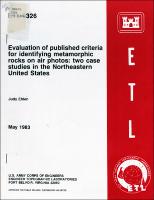Please use this identifier to cite or link to this item:
https://hdl.handle.net/11681/3196Full metadata record
| DC Field | Value | Language |
|---|---|---|
| dc.contributor.author | Ehlen, Judy, 1944- | - |
| dc.date.accessioned | 2016-03-16T15:01:43Z | - |
| dc.date.available | 2016-03-16T15:01:43Z | - |
| dc.date.issued | 1983-05 | - |
| dc.identifier.uri | http://hdl.handle.net/11681/3196 | - |
| dc.description | Report | - |
| dc.description | Abstract: Although there are stated Army needs for rock type information, there are as yet few reliable procedures for obtaining much of this information, particularly for metamorphic rocks, via remote sensing. Published criteria for identifying metamorphic rocks by air photo patterns were systematically tested on regionally metamorphosed rocks in west-central Vermont and near West Point, New York, and were found inadequate for use as predictive tools. Mapping units were discriminated on the air photos by evaluating the pattern elements of landform, drainage-plan, drainage-cross section, photo tone, and photo texture. They were identified by comparing each pattern element to its counterpart for each rock type in the published criteria. The most common pattern element rock name was selected as the name for the mapping unit. To avoid bias, geo-logical data were not obtained until after the identification process was completed. The predicted rocks names were then compared to geologic maps and field data to determine their accuracy. Only 20 of the 74 verifiable predictions were correct. Probable causes for these results are (l) that the published criteria are incomplete and internally inconsistent and do not include all the rock types found in the study areas; (2) that climatic and structural, or tectonic, factors, apparently not considered in the published criteria, play a significant role in determining rock type photo pattern; and (3) that the glacial history of these areas has affected the characteristic photo patterns of the rocks encountered. Moderate success was achieved, however, where lithologic diversity and structural complexity were low; when scales were 1:35,000 or larger; and with metamorphic rocks of higher grade and/or sedimentary origin. Similar techniques have proven successful for identifying igneous and sedimentary rocks on air photos, so development of more accurate criteria for metamorphic rocks, taking these factors into consideration, is continuing. These techniques are very useful in reconnaissance mapping, particularly in remote areas with difficult access. | - |
| dc.publisher | U.S. Army Engineer Topographic Laboratories. | - |
| dc.publisher | Engineer Research and Development Center (U.S.) | - |
| dc.relation | http://acwc.sdp.sirsi.net/client/en_US/search/asset/1047550 | - |
| dc.relation.ispartofseries | ETL ; 0326. | - |
| dc.rights | Approved for public release; distribution is unlimited. | - |
| dc.source | This Digital Resource was created from scans of the Print Resource. | - |
| dc.subject | Air photo patterns | - |
| dc.subject | Metamorphic rocks | - |
| dc.subject | Photo geology | - |
| dc.subject | Remote sensing | - |
| dc.title | Evaluation of published criteria for identifying metamorphic rocks on air photos : two case studies in the northeastern United States | - |
| dc.type | Report | en_US |
| Appears in Collections: | Technical Report | |
Files in This Item:
| File | Description | Size | Format | |
|---|---|---|---|---|
| ETL-0326.pdf | 5.14 MB | Adobe PDF |  View/Open |